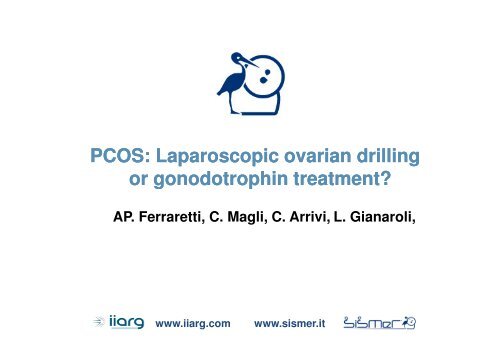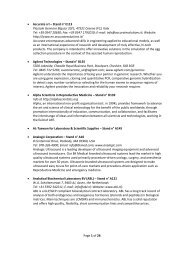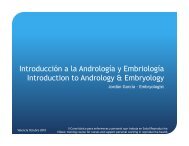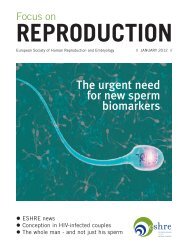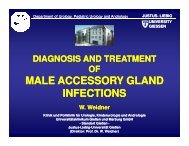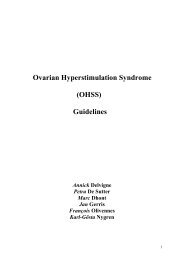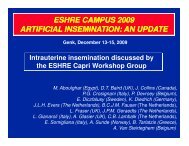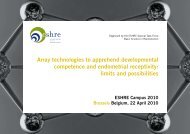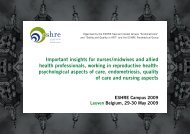PCOS: Laparoscopic Laparoscopic ovarian drilling or ... - eshre
PCOS: Laparoscopic Laparoscopic ovarian drilling or ... - eshre
PCOS: Laparoscopic Laparoscopic ovarian drilling or ... - eshre
Create successful ePaper yourself
Turn your PDF publications into a flip-book with our unique Google optimized e-Paper software.
<strong>PCOS</strong>: <strong>Laparoscopic</strong> <strong>ovarian</strong> <strong>drilling</strong><strong>or</strong> gonodotrophin treatment?AP. Ferraretti, C. Magli, C. Arrivi, L. Gianaroli,www.iiarg.com www.sismer.it
<strong>PCOS</strong><strong>PCOS</strong> is the most common endocrine dis<strong>or</strong>der in women (6- > 10%).The prevalence is similar in various populations w<strong>or</strong>ldwide (ancientdis<strong>or</strong>der that arose bef<strong>or</strong>e the migration of humans from Africa)Despite its negative effect on reproduction , <strong>PCOS</strong> was able to persistbecause many women with <strong>PCOS</strong> are able to conceive spontaneouslyand because of its “ survival advandages effects” during evolution.The etiology is still unclear (complex genetic condition influenced byenvironmental fact<strong>or</strong>s )Different phenotypes : considerable individual variation and ethnicdifferences ( clinical hyperandrogenism is not expressed in Asian <strong>PCOS</strong>patients )Frequently associated with insulin resistance , obesity, infertility obstetricalcomplication and long-term effects ( type 2 diabetes and cardiovasculardisease )
<strong>PCOS</strong>Diagnostic criteria :- National Institute of Health ( 1990) : both hyperandrogenism andchronic anovulation.- Rotterdam criteria ( ESHRE/ASRM 2003) - Two of the followingcondition : hyperandrogenism, chronic anovulation , polycyscticovary- Androgen Excess Society ( 2006) : hyperandrogenism as anecessary fact<strong>or</strong> (± <strong>ovarian</strong> dysfunction and /<strong>or</strong> polycystic ovary)Treatment of :- clinical symptoms- infertility
2010
Consensus on Infertility treatment of <strong>PCOS</strong>RecommendationsFirst-line treatment : CC (max 6 cycles) ± metf<strong>or</strong>minSecond-line intervention : laparoscopic <strong>ovarian</strong>surgery (LOS) <strong>or</strong> Gn stimulationThird-line treatment : IVF
OBJECTIVECompare the effectiveness of laparoscopic <strong>ovarian</strong> diathermy (LOD) vsclomiphene citrate plus metf<strong>or</strong>min in infertile patients with CC-resistantpolycystic ovary syndromeRESULTS:No significant difference per cycle was observedPregnancy: (15/92 pts [16.3%] vs 14/107 pts [13.1%]; P = .521)Live-birth (13/92 pts [14.1%] vs 12/107 pts [11.2%]; P = .536)Cox regression analysis: patients under medical treatment, compared withwho received surgical treatment, hada relative risk of pregnancy of 1.2 (95% confidence interval, 0.61-2.44; P = .582)a relative risk of live-birth of 1.4 (95% confidence interval, 0.63-2.96; P = .425).
Infertility treatment of <strong>PCOS</strong>RecommendationsCounselling and Lifestyle modifications (Obesitynegatively affects the efficacy of any infertility treatment )First-line treatment : CC (max 6 cycles) ± metf<strong>or</strong>minSecond-line intervention : laparoscopic <strong>ovarian</strong>surgery (LOS) <strong>or</strong> Gn stimulationThird-line treatment : IVF
Probabily of delivery andTime to deliveryTubal/pelvicpelvic/malesevere fact<strong>or</strong>sMild sub-fertilityIdhiopatic infertility<strong>PCOS</strong>IVF/ICSIIUICCLOSGnIVF/ICSIIVF/ICSILBR : 60% 70% 85%
Fact<strong>or</strong>s to guide f<strong>or</strong> patient-tail<strong>or</strong>ed approach(deviation from the 3- lines strategy )Other (minimal?) fact<strong>or</strong>s releated to infertility IVF/ICSIAge
<strong>PCOS</strong> and AgeAging<strong>PCOS</strong> patients gain regularReduction of the <strong>ovarian</strong>menstrual cycles whenreserve is less affectedaging by age (?)Visser et al, Reproduction 2006
Fact<strong>or</strong>s to guide f<strong>or</strong> patient-tail<strong>or</strong>ed approach(deviation from the 3- lines strategy )Other (minimal?) fact<strong>or</strong>s releated to infertility IVF/ICSIAge ?Duration of infertility ( and age) ?Time to pregnancy can be very long following the 3-linesrecommended schemeBMI ?Obesity negatively affects the efficacy of any infertility treatment ( whichm<strong>or</strong>e ?)Initial screening characteristics of women ?
Infertility treatment of <strong>PCOS</strong>RecommendationsCounselling and Lifestyle modificationsFirst-line treatment : CC (max 6 cycles) ± metf<strong>or</strong>min
2009The aim of this study was to test thehypothesis that LOD may be superi<strong>or</strong> toCC as a first-line treatment.
At 12 months follow-up, the pregnancy rate after LOD was 52%, which was notstatistically [P ¼ 0.26, OR 1.6 (0.6 – 4.2)] different from that (63%) of CC.high CC dose.www.iiarg.com www.sismer.it
Clomiphene CitrateStarting dose 50 mg/day f<strong>or</strong> 5 days; maximum 150 mg/day.Should be limited to six (ovulat<strong>or</strong>y) cycles• Produces ovulation in 75%–80% and a• Conception rate of up to 22% per cycle•Cumulative live-birth rates vary between 50% to 60% f<strong>or</strong> up to six cycles• US monit<strong>or</strong>ing is not mandat<strong>or</strong>y ( usefull in the fist cycle to allow adjustmentin subsequent cycles)• No evidence that HCG improves conception•Adverse effects :OHSS is rareMultiple pregnancy rates are under 10%, ( 9% twins. < 1% triplets)
Clomiphene Citrate
Clomiphene CitrateGhobadi et al tested thenomogrram and found it notaccurate f<strong>or</strong> use( Fert Steril , 2007)
Clomiphene CitrateCC resistance is higher in <strong>PCOS</strong> women withFSH recept<strong>or</strong> Ser/Ser polym<strong>or</strong>phism comparedto Asn/Ser and Asn/Asn groups ( 28% vs 14%)Overbeek et al, Hum Reprod 2009 (multivariate logisticregression model c<strong>or</strong>rected f<strong>or</strong> age and all other <strong>PCOS</strong>parameters)
CC + lwo FSH doses (± IUI )Ovulation in ~50% of CC resistent patientsMean number of preovulat<strong>or</strong>y follicles : 2.2 ± 1.4Very few small ( > 10 mm ) folliclesPR/cyle : 16%Clomiphene citrate(100 mg) f<strong>or</strong> 5 daysFSH (75- 100 IU) everyother day from CC 3°dayCycle dayCycle daysUS
LOD <strong>or</strong> Gn stimulation ?Second - line intervention after CC failureCC failure :No ovulation up to150mg/day( CC –resistance)Regular ovulation butno pregnancy after 6cyclesLOD <strong>or</strong> Gn ?to achieve (unifollicular)ovulation and (singleton)live birthLOD <strong>or</strong> Gn ?to improve oocytecompetence and achieve(singleton) live birth
Oocyte competenceMeiotic maturation( resumption of meiosisCytoplasmaticmaturationEpigeneticmaturation
Oocyte competence in <strong>PCOS</strong>LH persistant hypersecretionAltered activation of the meioticprocessMeiotic maturation( resumption of meiosis)CytoplasmaticmaturationDecreased calcium oscillationIntra<strong>ovarian</strong> hyperandrogenismHyperinsulinemiaStimulate follicle recruitment( Dumesic et al, 2007)Epigeneticmaturation
High level of LeptinLeptin is a Protein of the ob gene (chromosom 7 )secreted from adipocytes thatregulates at the central level thefood intakeDiscrepancy between elevatedleptin and its central actionsupp<strong>or</strong>t the concept that obesityis a Leptin resistance conditionRedroductive Target <strong>or</strong>gansare hypothalamus, ovary andendometriumIt regulates the gonadotropinssurge that starts pubertaldevelopmentSeems to affect steroidogenesison follicular cellsInsulin resistance andHyperinsulinemiaFrequent in abdominal obesitywith hyperandrogenemia:Insuline stimulates Androgenproduction ?Androgens promotes IR?Contrary to what occur inother tissues, the ovaryremains responsive toinsulin andhyperinsulinemia is a keyfact<strong>or</strong> f<strong>or</strong> excess androgenproduction by the thecacells
Infertility treatment of <strong>PCOS</strong>RecommendationsCounselling and Lifestyle modificationsFirst-line treatment : CC (max 6 cycles) ± metf<strong>or</strong>minSecond-line intervention : laparoscopic <strong>ovarian</strong>surgery (LOS) <strong>or</strong> Gn stimulation ( both efficient)Third-line treatment : IVF
Ovarian surgical treatment f<strong>or</strong> <strong>PCOS</strong>Surgical <strong>ovarian</strong> wedge resection :first established treatment f<strong>or</strong> anovulat<strong>or</strong>y <strong>PCOS</strong> patients (Stein 1939). Thesummated experience in the literature ( Donesky, 1995) :1766 treatmentsand a PR of 58.8%. Went out of favour in the 1970s( f<strong>or</strong> the high risk ofadhesions with the introduction of medical ovulation<strong>Laparoscopic</strong> access :1972 ( Cohen et al) : <strong>ovarian</strong> biopsy with Palmer f<strong>or</strong>ceps1984 (Gjonnaess et al) : electrocauterization ( diathermy) : 5-10 points ineach ovary f<strong>or</strong> f 5-6 seconds ( 300-400 W)1988 ( Huber et al) : laser vap<strong>or</strong>isazion ( 3-4 drills 5-10 mm long and 4 mmdeep) . All types of laser have been used (CO2, argon,YAG).1993 ( Armar et al) : minimal diathermy (four puncture f<strong>or</strong> 4 seconds)
<strong>Laparoscopic</strong> Ovarian Drilling (LOD)Review of 17 studies, 1664 cases (Kovacs,2000 ) :- homogeneous results ( spontaneous ovulation in > 60% of casesand 50% PR) whatever the technique ( diathermy <strong>or</strong> laser )Four to ten punctures are effective.M<strong>or</strong>e punctures have been associated with premature <strong>ovarian</strong>failure ( Amer,2203; Malkawi,2003)Adhesion f<strong>or</strong>mation rate: 0-100%( Gurgan et al review 1994).Higher risk with CO2 laser vs cauterization.LOD of one vs two ovaries : 2 RCT , 40 cases : no evidence ofdifference ( Cochrane review , Farquar et al .2010)
<strong>Laparoscopic</strong> Ovarian Drilling (LOD)Review of 17 studies, 1664 cases (Kovacs,2000 ) :LOS has been suggested f<strong>or</strong> nonfertlityindications such menagement ofirregular cycles <strong>or</strong> hyperandrogenism.- homogeneous results ( spontaneous ovulation in > 60% of casesand 50% PR) whatever the technique ( diathermy <strong>or</strong> laser )Four to ten punctures are effective. M<strong>or</strong>e punctures have beenassociated Because with premature of the lack <strong>ovarian</strong> of long-term failure ( Amer,2203; evidenceMalkawi,2003)and the risks of surgery, this approachcannot be recommendedAdhesion f<strong>or</strong>mation rate: 0-100%( Gurgan et al review 1994). Higherrisk with CO2 laser vs cauterization.LOD of one vs two ovaries : 2 RCT , 40 cases : no evidence ofdifference ( Cochrane review , Farquar et al .2010)LOS may be useful at anytime when infertile<strong>PCOS</strong> patients need to be evaluated bylaparoscopy to asess their pelvis????
Ovarian Steroidogenesis in <strong>PCOS</strong>CholesterolPregnenoloneLH3 betaTheca cellDysregulation of 17-hydroxilase and 17,20-lyaseProgesterone17 alfahydroxilase17 OH3 betaPregnenolone17- 20lyaseDehydroepiandrosterone3 beta17 alfahydroxilase17 OHProgesterone17- 20lyaseAndrostenedione17-beta HSDTestosteroneFSHP450 aromataseOestroneP450 aromataseOestradiolGranulosacellLow aromatase activity (multiple small follicles)
Mechanism of action of LOD : unclearLOD destroy <strong>ovarian</strong> LH androgen-producing tissue ( effect on theTheca cellCholesterol<strong>ovarian</strong> steroidogenesis reductions in intra<strong>ovarian</strong>androgens production )Pregnenolone3 beta17 alfa1987) hydroxilase17 OH3 betaPregnenoloneDysregulation of 17-hydroxilase and 17,20-lyaseThe local effect is followed by a fall in the serum levels ofandrogens and luteinsingProgesteroneh<strong>or</strong>mone (LH) and an increase infollicle-stimulating h<strong>or</strong>mone (FSH) levels (Armar 1990; Greenblatt17- 20IVF ?? lyase )Dehydroepiandrosterone3 beta17 alfahydroxilase17 OHProgesteroneThus both local and systemic effects are thought to promotefollicular recruitment, maturation and subsequent ovulation17- 20lyaseAndrostenedione17-beta HSD P450 aromataseTestosteroneFSHLOD is able to rest<strong>or</strong>e CC sensitivity ( and to preventi OHSS inChanges in blood flow?Stimulation of <strong>ovarian</strong>nerves?P450 aromataseOestroneOestradiolThe beneficial effect may continue f<strong>or</strong> years ( few data )GranulosacellLow aromatase activity (multiple small follicles)
Gn stimulation( <strong>PCOS</strong> women are specifically prone to execessive follicledevelopment)Conventional protocol ( starting dose of 150 IU) : high rate of ovulationbut unacceptable rate of multiple follicular development (23%) and highrisk of severe OHSS ( > 4%) . No longer recommended.Since early 90’, low-dose protocols have been used f<strong>or</strong> <strong>PCOS</strong> patients.Currently , two low dose regimens are used:- Step-up regimen : FSH starting dose of 37.5 – 50 IU/day f<strong>or</strong> 14 daysand small weekly dose increment ( 50%) .- Step-down regimen : FSH starting dose of 75-100 IU and stepwisereduction as soon as follicular developmentis observed Intense <strong>ovarian</strong> response
Low –dose Gn protocolsStep – up( 3 trials ,1991-1994)Step-down( 1 trial , 1995 )Ovulation rate 68- 74% 91%Monofollicular cycles 73% 62%Pregnancy rate/ cycle 16-20%% 17%Cumulative PR in 3- 6cycles55- 73% 47%Multiple PR 4-18% 8%OHSS 1% 2%Preventing all multiple gestation and OHSS is not possible at this timeConsensus on infertility treatment related to <strong>PCOS</strong>,2008
Gn stimulation in <strong>PCOS</strong>Intense monit<strong>or</strong>ing ( US and E2 ) is required to reduce complications and cycle has to becancelled when m<strong>or</strong>e two follicles > 14 mmThe duration of gonadotropin therapy generally should not exceed six ovulat<strong>or</strong>y cycles. Nopregnancy with 6 cycles signifies resistanceDifferent Gn preparationuFSH vs rFSH : no differencesFHS vs HMG : similar results ( LH exogenous administration in <strong>PCOS</strong> has not detrimentaleffects, )FSH different isof<strong>or</strong>ms ( to reproduce n<strong>or</strong>movulat<strong>or</strong>y cycles ) : no tested in <strong>PCOS</strong>Sequential protocols ( FSH LH/HCG) to drive selective maturation of one singlefollicle and atresia of small follicles ( tested by Hugues et al 2005 in n<strong>or</strong>mogonadotropicoligo- anovulation)GnRH analogues to n<strong>or</strong>malize LH secretion :The addition of Gn RH agonist increases the OHSS risk and does not increases the PR. Itsuse is not justify in <strong>PCOS</strong>GnRH antagonist : no data in ovulation induction f<strong>or</strong> <strong>PCOS</strong>
<strong>PCOS</strong> in ARTGnRH antagonistSingle dose (3mg)HCGMultiple dose (0.25mg/day from day ) fixed 1 <strong>or</strong>flexible protocolFSHDay of FSHBenefit in <strong>PCOS</strong>( Laines et al Hum Reprod 2007 )
<strong>Laparoscopic</strong> <strong>ovarian</strong> <strong>drilling</strong><strong>or</strong>gonodotrophin treatment?EfficacySafetyCostsCochrane review (2010)5 RCT trials ( 1998-2005)174 vs 165 patients
LOD vs Gn?EfficacyLODGnOvulat<strong>or</strong>y cycles 78% 90%PR/cycle9% 15%Miscarriage rate 14% 16%LBR6 months follow –upvs 3 FSH cyclesLBR12 months ± medical ovulationvs 6 FSH cyclesLBR after 24 months ±medicalovulation15% 20%67%Only LOD 34%Plus CC 49%Plus Gn 67%82%60%
LOD vs Gn?Safety and costsLODGn ( step-up lowdose)Monofollicular ovulation 100% 73%Multiple PR 1% 17%OHSS 0% 3%Risks related to surgery Present AbsentAhesions f<strong>or</strong>mation Low risk (< 10 holes) AbsentPremature <strong>ovarian</strong> failure Rare (< 10 holes) AbsentQuality of lifeNo differencesCosts / term pregnancy 11.301 € 14.489 €Duration of the beneficialeffectYears ( few data )Stimulated cycles
LOD vs Gn?SpecificindicationsAmer et al ,2004Retrospective study( 200 <strong>PCOS</strong>women)Saleh et al ,2001Logistic fact<strong>or</strong>sLODPersistent high LHlevels (> 10 IU/ML)Need of laparoscopicevaluationof thepelvisHyperinsulinemiaPatient living too farfrom the hospital f<strong>or</strong>intensive monit<strong>or</strong>ingGnAdvanced age (> 35 ? >38?)Long duration of infertilityObesityMarked hyperandrogenismNo doct<strong>or</strong> skill f<strong>or</strong> LOD ?
LOD <strong>or</strong> Gn stimulation ?Second - line intervention after CC failureCC failure :No ovulation up to150mg/day( CC – resistance)LOD <strong>or</strong> Gn ?to achieve (unifollicular)ovulation and (singleton)live birth
LOD <strong>or</strong> Gn stimulation ?Second - line intervention after CC failureCC failure :Regular ovulation butno pregnancy after 6cyclesIVF ?to by-pass nondiagnosed infertilityfact<strong>or</strong>s ?LOD <strong>or</strong> Gn ?to improve oocytecompetence and achieve(singleton) live birth
IVF LiteFixed stimulation protocolGnRHantagonistHCGClomiphene citrate(100 mg)FSH (150 IU)Cycle dayCycle days
IVF LITE in <strong>PCOS</strong>Cycles 42Patients 23N° oocytes 185 (5,8 ± 2.4)M2 114 (3.6 ± 2.5)Inseminated 912 PN (%) 76 (83,5)Embyos day 2 (%) 76 (100)Gr.1 (%) 68 (89,5)Embryos Transferrred73 ( 1.8 per cycle)OHSS 0
Primary end pointCumulative ongoing pregnancy rateper <strong>PCOS</strong> patient ( 23 patients)1° cycle 2° cycle 3° cycleLBR 36% 51% 60%
Ovarian <strong>drilling</strong> : different approaches<strong>Laparoscopic</strong> diathermy <strong>or</strong> laserTransvaginal Hydrolaparoscopy ( next lecture )Transvaginal ultrasound-guided <strong>ovarian</strong> <strong>drilling</strong>- 1991 Yasuyuki, Japan ( 8 patients )- 2001 Ferraretti et al, Italy ( 11 patients)- 2009 Badawy et al, 2009
Ovarian <strong>drilling</strong><strong>Laparoscopic</strong> diathermy <strong>or</strong> laserTransvaginal Hydrolaparoscopy ( next lecture )Transvaginal ultrasound-guided <strong>ovarian</strong> <strong>drilling</strong>A new surgical treatment f<strong>or</strong> improving ARTOutcome in <strong>PCOS</strong> patientsFerraretti et al, Fertility and Sterility2001;76:812
<strong>PCOS</strong> patients undergoing ART vs ControlControl(tubal infertility)<strong>PCOS</strong> withadequate response<strong>PCOS</strong> withpo<strong>or</strong> perf<strong>or</strong>manceNo. of patients 502 32No. of cycles 873 47No. of cancelled cycles 137(15%) 0No of oocytes/retrieval 11.7 ± 7 13.8 ± 5Fertilization rate 73% 56%Cleavage rate 78% 83%No of transferred cycles 537* 44No of pregnancies (%) 226(42) 18 (41)Implantation rate 26% 24%Ab<strong>or</strong>tion rate 11% 14%243421 (56%)11.3 ± 448%52%110//
US guided TVOD in ARTFerraretti et al Fertility and Sterility 2001;76:812
Results ( 24 <strong>PCOS</strong>)Bef<strong>or</strong>e TVODAfter TVOD* p < 0.05No of patients 24 23**No of cycles 34 30No cancelled 21 5*No of eggs 11.3± 4 13.2 ± 3Fertilization rate 48% 70%*Cleavage rate 52% 73%*Fresh transfers 8 21Thawed transfers 3 10Clin.pregnancies 0 15Delivery rate/cycle 0 47%*Delivery rate/patient 0 64%***One patient had a spontaneous pregnancy after TVOD
TVOD in young <strong>PCOS</strong> patients t<strong>or</strong>est<strong>or</strong>e spontaneous cyclesPersistent anovulationOvulat<strong>or</strong>y cycles12Patients number3456781 2 3 4 5 6Months after TVOD
US guided transvaginal <strong>ovarian</strong> <strong>drilling</strong> f<strong>or</strong> <strong>PCOS</strong>( Badawy et al , Fertil Steril 2009)RCT163 <strong>PCOS</strong> patients with CC resistanceLOD ( 81 pat) vs UDTN ( 82 patients)Main Outcome results : h<strong>or</strong>monal changes ,ovulation and pregnancyResults : no differences ( PR in six months : 22%vs25%)Conclusions :the ease to sheduling, reduced costs , rapidrecovery and no risk of adverse effects suggest it asa first-line treatment f<strong>or</strong> <strong>PCOS</strong> patients resistant toCC
Treatment of <strong>PCOS</strong> clomiphene-resistant:<strong>Laparoscopic</strong> <strong>ovarian</strong> <strong>drilling</strong><strong>or</strong>Gonodotrophin treatment<strong>or</strong>US- guided transvaginal <strong>ovarian</strong> <strong>drilling</strong>???www.iiarg.com www.sismer.it


